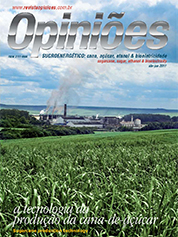Tomaz Caetano Cannazam Rípoli
Professor of Rural Engeneering at Esalq-USP
Op-AA-28
China and blocks
At the end of 2010, China launched a national program seeking to become the world’s largest citrus producer in 2025. Can there be any questions concerning the success of this and the reflexes for Brazil and the USA? One might imagine that for the sugarcane-based industry the Orientals are preparing something similar for the near future, apart from the already significant annual increase in sugarcane plantation areas in recent years.
There should be no doubt as to what that will mean for Brazil, whose industry continues in a state of enchantment, hypnotized and laughing heartily with respect to our production capacity.
Never before were profits so high! However, hidden behind the euphoria are elementary questions concerning management, agronomy, technology and logistics, which, if nowadays they little affect Brazilian competitiveness in the international market, it will not be long before a scenario change will take place, and when that happens, not even BNDES financing will solve the problem. The crisis will occur, not like a bubble, but rather like a tsunami.
There are five groups of factors that continue to merit attention, less “trial and error” and more rationality, but they are being masked due to the industry’s good phase:
1. Distorted focus of companies’ objectives (more concern about production increases than about increasing profitability).
2. Little investment in professional qualification (from machine operators to college degree professionals who work in the field).
3. Quality control of field operations is obsolete, imperfect and does not meet essential requirements, being nothing else than makeshift solutions.
4. Performance controls suffer from the same problem. The latter two produce tons of data, but few mills extract information from it to make decisions on reliable bases. The consequence: the “I think approach” prevails, based on “averages”. Imagine two people having lunch. One, a guzzler, eats everything, while the other merely watches. On average, both are well fed… They forget to use elementary scientific tools (correlations, regressions, variation coefficients, standard deviations, basic statistics), because they think this is for the college guys…
5. Many an inappropriate or sophisticated technology is implemented, when the right thing to do would be to implement adapted technologies.
Touching only on this last topic, here’s an example: it is basic, and yet most of the mills have still not grasped that a good harvest depends on good planting, which, in turn, depends on good soil preparation, while the improvement of mechanical harvesting systems’ performance depends on the correct systematization of blocks, with systematization meaning a broad one rather than any customary half-done solution.
The systematization of blocks for mechanical harvesting, in which the most modern equipment consists of 300 HP engines, actively engaged entities with higher capacities to receive and process raw material per time unit, encompassing onboard electronics, etc., begins with the correct formatting of blocks and the corresponding road system.
With terrain inclinations of 3 to 4% (depending on the type of soil), the crop residue left over from harvesting suffices to help prevent erosion, which is why contour lines are not necessary. Blocks must at least be 600 m long (Australia already has blocks measuring 1 to 1.2 km).
Enough patchwork! In more inclined areas, lots should be aligned with the contour lines, seeking to eliminate dead rows to the extent possible. Thus, one achieves better field efficiency.
Regardless of how good base cutters of harvesters are to align with micro slope imperfections, they are insufficient to diminish the volume of earth “collected”, ratoon damage and destruction, if during soil preparation an adequate leveling of such micro slopes (laser aligning has been available for decades) does not take place.
Apart from formatting blocks and aligning micro slopes, one should not neglect the alignment of the lot with the lanes (the lack to do so results in significant losses in over head maneuvering of the harvester and the bin tractor, again interfering with field efficiency). Spacing: If simple, it must at least be of 1.5 m. Many people still use 1.4 m, believing that 10 cm will result in increased agricultural productivity.
Nonsense! What are 10 cm when the variables mentioned below interact and result in spatial variability of agricultural productivity (AP) in a lot of more than 50%, which is absurd, when one considers this AP based on the criterion of planting lines? How: variety characteristics; the number of stalks for industrial processing; their sizes, their lengths, their unit weights, planting and shooting errors, spatial variability of physical and chemical characteristics of the soil; soil preparation quality and furrowing (lack of parallelism); variability of the number of viable buds planted per meter; lack of uniformity in the covering process; inadequate distribution of fertilizers, errors in applying pesticides (these two due to the lack of tuning and inadequate nozzles and doses), traffic inside the furrows and treading on ratoons.
Such conditions were already clearly shown in research made public by me and Sergio Paranhos, since 1972, when we studied and advocated alternative planting (0.90 x 1.60 m), nowadays an interesting trend, but in no way a novelty. These new college degree generations of technicians should read more, to obtain more information based on scientific knowledge, rather than only try to discover the squaring of the circle.
Finally, the Chinese “threat” is coming. Unless one adopts the necessary agronomic practices to increase profitability, we will not only import ethanol from the USA, but also sugar from China. In addition, we should cease to rely on Saint Peter in matters concerning our agricultural production. Sugarcane in Brazil is still hungry and thirsty! Irrigation shortens the path to worldwide competitiveness.




